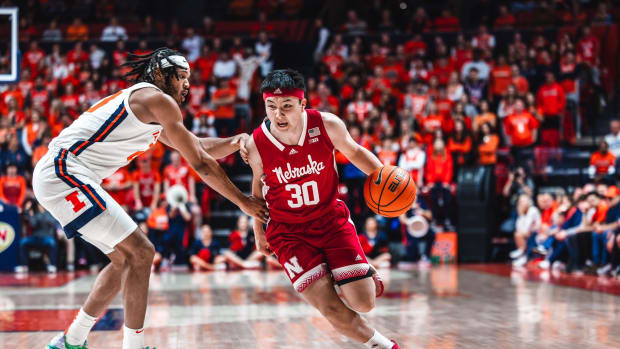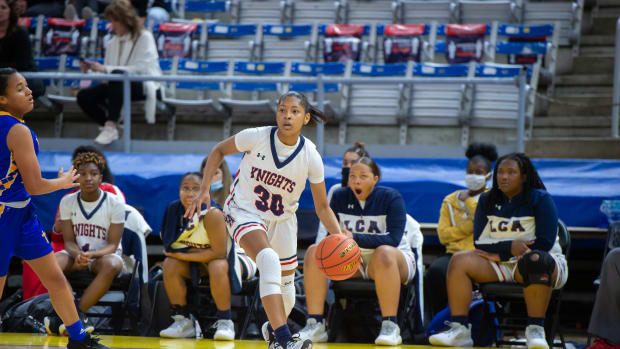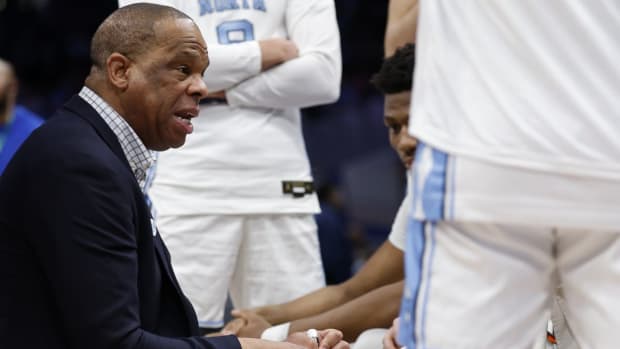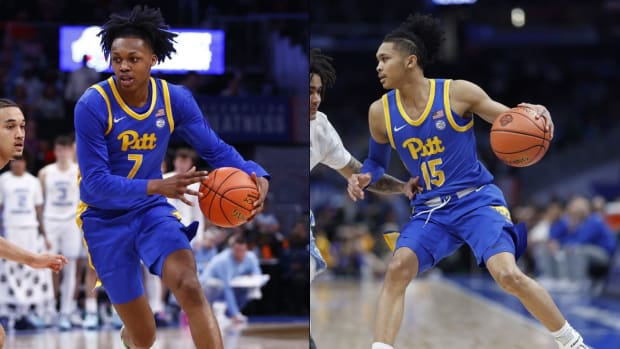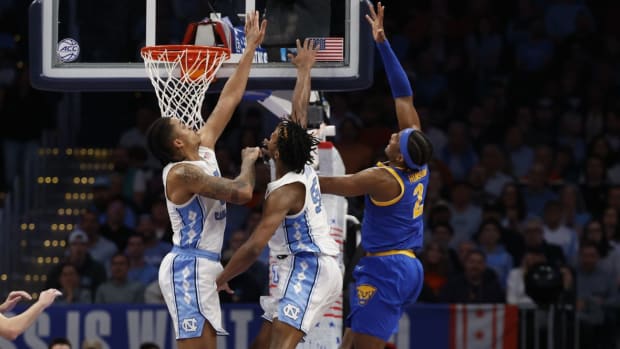March Madness Cinderella Rankings: The most likely teams to pull off big upsets
The Power Rankings is taking its annual, first-week-of-the-NCAA tournament respite from analyzing the elites and focusing on the Cinderellas (or at least Cinderella-ish teams) instead. These are the No. 11-or-lower seeds with the best chance of pulling off upsets.
(* Because this is being published on Tuesday, I'm not including any 11-seeds from the play-in games—but my favorite of that bunch is Wake Forest, which would rank No. 3 on this list if made it through to the first round.)
1. Rhode Island Rams
(Midwest No. 11, vs. Creighton)
The home-brewed composite of advanced metrics that I wrote about in Monday's Bracket Math column gives Rhody a 41.2% chance of winning here, and that's using Creighton's full-season numbers. Once you factor in the absence of injured and disgraced Bluejays point guard Mo Watson, I think the odds are closer to 50%, which makes URI the most likely first-round winner of the 11-or-higher seeds.I'm no fan of the Rams' shorts—the hero on this team is freshman guard Jeff Dowtin, who rolls them up at the waistband to hide that weird band of Ram-horn graphics—but love the way they defend on the perimeter. If you put every Division I team in a matrix with its defensive three-point rate (the ratio of 3PAs to overall FGAs a team allows) and defensive three-point accuracy allowed as the two axes, there isn't any real correlation between the two. But a few defenses seem to have mastered the ability to both limit three-point attempts and deflate three-point percentage, the best examples of which are Rhode Island, Duke and Saint Mary's.(Chart data source: kenpom.com)Watch this video of one of the Rams' defensive possessions against a three-point happy Davidson team in the semifinals of the A-10 tournament, and you'll see how some of of this works. Dan Hurley's team plays extended, pressure man-to-man, with hard close-outs on the catch, help-side defenders often staying glued to shooters and switches on high ballscreens.The result of all this is that Rhode Island allows the third-lowest jump-shot efficiency of any team in the nation, according to Synergy's unadjusted data …… and that might limit the effectiveness of the jump-shooters that Creighton will need to score, namely Marcus Foster and Khyri Thomas.
2. Middle Tennessee Blue Raiders
(South No. 12, vs. Minnesota)
I'm on the Middle Tennessee train for more than just the pleasure of saying Giddy Potts. The Blue Raiders are not an easy team to prepare for because they mix up defenses in unpredictable ways. You're likely to see three different looks over the course of a game—a switching man-to-man, a 2–3 zone and an extended, trapping 1-3-1 zone—and while Middle Tennessee has been majority-man over the course of the season, its run through the Conference USA tournament had two majority-zone games. Here are the splits, pulled from Synergy's game logs:The 1-3-1 seems to be coach Kermit Davis's curveball, but he likes to throw it early in the count, after one of the Blue Raiders' first made shots of a half. An opponent will inbound the ball, come up the court and see it extended like this:To give you a sense of how Middle Tennessee's defenses vary over the course of one half, I charted (off of film) all of its halfcourt defensive possessions in its win over Marshall in the C-USA title game. The Blue Raiders were far more likely to employ zone following a made shot, with the 2–3 being their base zone D:
3. East Tennessee State Buccaneers
(East No. 13, vs. Florida)
This is a gut-based (as opposed to analytics-based) pick; the eye test suggests the Buccaneers are athletic enough to hang with an SEC team, and I think ETSU's defensive pressure could give Florida problems.The Bucs rank 20th nationally in turnovers-forced percentage, at 22.0%, but I found a number buried deep within that turnover data that's particularly crazy: ETSU is the best team in the nation at forcing turnovers on baseline-out-of-bounds plays. Per Synergy, the Bucs have forced TOs on an absurd 31.7% of their opponents' BLOB sets, which comes out to slightly less than two turnovers per game.How in the hell is this happening? It's not all on stolen passes, but one thing ETSU refuses to concede—unlike a lot of D-I teams—is the deep-lobbed inbounds. The Bucs put a flailing-like-mad guy on the passer (often 6'9" Indiana transfer Hanner Mosquera-Perea) and have other players chase the lobs like cornerbacks breaking up fade routes. Here's one example from the SoCon tourney against Samford:And another on a high-arcing pass all the way into the backcourt:ETSU also denies the inbounds passes and plays a zone-like D underneath the basket to try to avoid getting caught up in screens:If ETSU seals an upset by stealing an inbounds, you can tell your friends you saw it coming.
4. Xavier Musketeers
(West No. 11, vs. Maryland)
My composite metric actually gives the Musketeers a 54.9% chance to beat Maryland, although that's using season-long data. Anyone who's watched Xavier in the latter half of February and early March can see that, sans injured point guard Edmond Sumner, this is a much weaker team—but one that still has enough talent and NCAA tournament experience to not be written off entirely.This isn't a badge of honor for the Musketeers—it's more of a quirk—but my Favorite Xavier Fact in 2016–17 is that it's one of just three teams in all of D-I for whom long, two-point jumpers have been more efficient than threes in the halfcourt:Much of that is due to junior guard Trevon Bluiett being uniquely adept at the long two (see his data in the chart above). So if you watch him do something that for a normal player would seem inefficient—such as in the GIF below, where he turns down a three to create an off-the-dribble, contested, fadeaway long two—hold off on screaming at your screen.
5. Nevada Wolf Pack
(Midwest No. 12, vs. Iowa State)
The Wolf Pack are the perfect matchup for Iowa State because Nevada is becoming the Iowa State of the Mountain West, loading up on talented transfers who are thriving in a new program. Wolf Pack point guard Marcus Marshall is exactly the kind of second-chance guy Fred Hoiberg would've tried to woo to Ames (and the Cyclones did reportedly pursue him in 2015). Marshall had a verbal altercation—and then an abrupt falling-out—with Missouri State coach Paul Lusk in January 2015 and left after being suspended for "conduct detrimental to the team."Marshall's career wasn't exactly stellar up to that point—he played in just 25 games over his sophomore and junior seasons at Missouri State due to injuries, the suspension and the transfer—but he's emerged as one of the nation's most efficient, scoring point guards, with a 121.3 offensive rating on 23.9% usage. Nevada coach Eric Musselman, a longtime former NBA head coach and assistant, now calls Marshall "the best shot maker in late games I’ve had, including NBA players that I’ve coached." I wouldn't mind seeing Marshall and Iowa State's Monte Morris dueling it out, big shot for big shot, in the final minutes of their first-round game in Milwaukee.
6. North Carolina Wilmington Seahawks
(East No. 12, vs. Virginia)
In a different bracket, the Seahawks might have been my No. 1, 2 or 3 Cinderella pick; I love head coach Kevin Keatts’s offense but do not love its matchup with Virginia. How often do you run into the nation's stingiest defense—and a top 10 team overall in efficiency—as the 12 in a 5–12 game?If UNC Wilmington pulls off this upset, it might be by leveraging the pick-and-roll finishing abilities of 6'7" sophomore forward Devontae Cacok, who's shooting a stunning 87.0% (and scoring 1.70 PPP) on his 61 pick-and-roll finish attempts, according to Synergy. Of NCAA tournament players with at least 50 P&R finishing possessions this season, the next-closest guy isn't even all that close; it's Creighton center Justin Patton, at 70.2% (and 1.39 PPP) on 54 tries.Cacok isn't a three-point threat, so his involvement in the ballscreen is all via rim-rolls, where he loves to receive lobbed passes. UNC-W will often have Cacok screen, roll, then come back up to screen again, and hit him on the second roll; check it out in the short video edit below:
7. Princeton Tigers
(West No. 12, vs. Notre Dame)
While ultra-heavy three-point dependence hasn't proven to be a good strategy for a juggernaut trying to make a deep NCAA tournament run, it can work as a boom-or-bust approach for pulling off a first-round upset. Princeton is the third-most three-point dependent offense in the bracket, taking 45.9% of its shots from deep, and Notre Dame is 11th, at 40.8%.The Irish are the superior team by a decent margin, and I'm not sure if Princeton can contain Bonzie Colson, but if the heat conditions are right on the Cinderella side, the Tigers have the long-range firepower—with four 40+% three-point shooters in their starting lineup—to advance and face West Virginia.
8. Vermont Catamounts
(Midwest No. 13, vs. Purdue)
Two Cinderella candidates are coming into the NCAA tournament with extreme, positive momentum: Princeton, which started 4–6 and has gone 19–0 since, its last loss coming on Dec. 20; and Vermont, which started 8–5 and has gone 21–0 since, its last loss occurring on Dec. 21. The Tigers and Catamounts were must-includes on this list on that basis alone, and Vermont runs high-quality, downtempo, non-three-point-reliant offense, having made 58.0% of its twos in America East play.This is a dangerous team whose spot in the Cinderella Rankings is depressed due to a rough matchup—one that makes me think back to the last time Vermont lost, which was at Butler. In that game, 6'7" Bulldogs forward Andrew Chrabascz shot 10-of-13 on twos, having his way on the interior with easy moves like this:While Chrabascz is a nice interior player, he's no Biggie Swanigan or Isaac Haas in the post. The Catamounts will need to throw double-teams at both of them and then hope they're surrounded by the coldest, long-range shooting version of Purdue.
Enter Here
Cousin Sal Bets The House
Fill out a perfect bracket, win Cousin Sal’s L.A.-area home.
Bonus: If You Must Pick a No. 16 Seed, Take ...
NC Central (Play-In Game; Midwest No. 16, vs. Kansas)
The Eagles need to win their play-in game to set up a meeting with the Jayhawks in Tulsa. If that happens, my composite-advanced-metrics model gives them a 5.0% chance of beating KU, the highest odds of any 16 seed in a first-round game. One-in-20 is a serious long shot, but weird stuff happens to Kansas in the NCAA tournament (see: Northern Iowa, VCU, Stanford, etc.), and the Jayhawks—who just went one-and-done in the Big 12 tournament while Josh Jackson was suspended—have a bad habit of letting lesser teams hang around in games this season.
NC Central starts five seniors, excels at defending jump shots, and has an offense that's odd enough—it spreads the floor and almost never tries to post up—to create problems. I have very limited faith here, but there is a chance.









